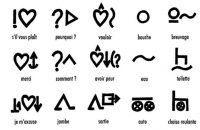








Blissymbolics is a communication system originally developed by Charles K. Bliss (1897-1985) for the purpose of international communication. It was first applied to the communication of children with physical disabilities by an interdisciplinary team led by Shirley McNaughton at the Ontario Crippled Children's Centre (now the Bloorview MacMillan Centre) in 1971.
The Blissymbolics language is currently composed of over 5,000 graphic symbols. Each symbol or Bliss-word is composed of one or more Bliss-characters which can be combined and recombined in endless ways to create new symbols. Bliss-words can be sequenced to form many types of sentences and express many grammatical capabilities. Simple shapes are used to keep the symbols easy and fast to draw and because both abstract and concrete levels of concepts can be represented, Blissymbolics can be applied both to children and adults and are appropriate for persons with a wide range of intellectual abilities.
Blissymbols:
These are quick and easy to learn
It can be used at a pre-reading level, but are sophisticated enough to allow expression of thoughts, ideas and feelings
It can be expanded as ability grows